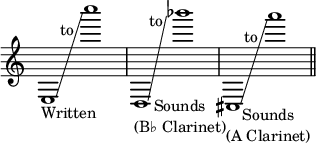Instruments of the Modern Symphony Orchestra/CLARINET
CLARINET
Clarinetto
Klarinette
Clarinette

Gustave Langenus
N.Y. Philharmonic Orchestra
Unlike the oboe, english horn, and bassoon, the clarinet is of cylindrical bore, and is played with a mouthpiece to which is bound a single flat reed of cane.
Owing to its large range, variety of tone colors, facility of execution, and power of swelling and diminishing its tones, the clarinet is generally conceded to be the most useful, as well as the most beautiful, of all the wood-wind instruments.
The clarinet comprises four registers, which can be blended without perceptible break by the skillful performer. The first or lowest is dark and ominous. The second consists of four or five dull, weak, notes of inferior quality. The third or medium register is of singular beauty, combining nobility, tenderness, and that limpid quality for which the clarinet is distinguished. The highest register is brilliant, but difficult to subdue, hence useful mainly in forte passages.
Clarinets are made in five or six different keys. All except the clarinet in C are transposing instruments. In the modern symphony orchestra the two (or three) clarinets are pitched in A or in B flat. The latter sounds one tone lower than written; the former, in A, sounds a tone and a half lower than written. Compositions in sharp keys are usually scored for the A clarinet: in flat keys for the B flat instrument.


N.Y. SYMPHONY ORCHESTRA